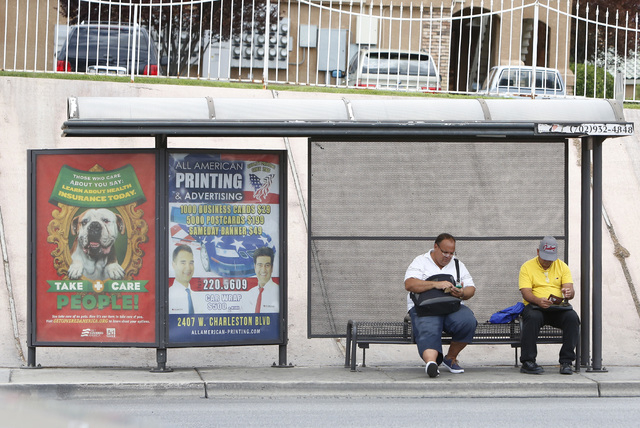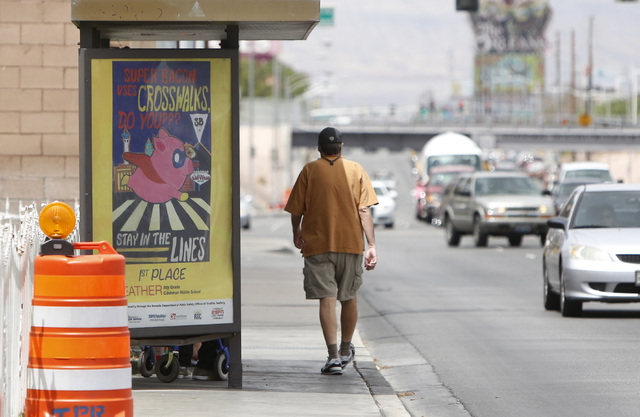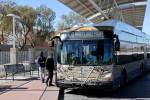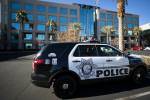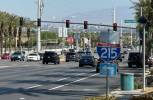Commission urged to do more to prevent bus stop tragedies
When an out-of-control vehicle is careening toward a bus shelter, how can someone waiting at the bus stop escape when the back of the shelter is an unyielding metal mesh panel?
That’s what community activist Peter “Chris” Christoff wanted to know from members of the board of the Regional Transportation Commission of Southern Nevada at Thursday’s monthly board meeting.
Christoff also wanted to know what was taking the commission so long to act since the agency was given authority to move its shelters farther away from the street onto public property in 2007 and a horrific accident that took the life of Patricia Hoff and turned Porsche Hughes into a double amputee occurred in 2008.
Since that time, 30 people have been killed or maimed at bus stops by runaway vehicles, including two people who died in March this year.
“There must be a better way to protect people than letting them sit in an iron cage that they can’t get out of,” Christoff said during the meeting’s public comment period.
Matters raised in a comment period can’t be acted on by public bodies in accordance to the state’s open meeting law.
Christoff advocates removing the metal mesh backing at bus shelters — a remedy that won’t help for hundreds of shelters that back up to walls separating them from residences or businesses.
Addressing newly appointed commission member Carolyn Goodman, the mayor of Las Vegas, Christoff quoted her husband, Oscar, who preceded her as mayor.
“I remember him saying, ‘I don’t ever want to see an accident like this ever again,’ when he was on this board,” Christoff said.
While board members couldn’t address the issue Christoff raised, Carl Scarbrough, manager of advertising and transit amenities for the Regional Transportation Commission, said the safety of bus stops across the valley has been an ongoing concern since that 2008 accident on Boulder Highway.
There are 3,400 bus stops valleywide and about 2,000 of them have shelters. The rest are marked with signs with no seating.
Bus shelters are hit two to three times a month, but most collisions are never noticed because there are no bus riders at the stop and the motorist leaves the scene without filing a report.
Scarbrough said the ultimate solution to making bus shelters safer isn’t going anywhere — reducing speed limits along bus routes across the city — because motorists won’t stand for it or would likely disobey posted limits.
Citing the high level of auto-pedestrian accidents and auto-bicycle accidents across the valley, Scarbrough said the issue is a much bigger problem than just the design of bus shelters.
“If we really want to do something about this, we have to start with doing more about driving under the influence and distracted driving,” he said.
That means stricter laws, harsher penalties, better enforcement and slower speed limits, he said.
Scarbrough based his views on engineering studies conducted after the 2008 crash.
Engineers determined that based on national crash data, 80 percent of all roadway crashes occur within 4 feet of the roadway. That led the commission to begin an effort to move shelters farther away from the road, observing a 5-foot standard.
But that’s impossible in many locations because sidewalks are narrow and there is no room to move the shelters. In some locations, the sidewalks and shelters are against block walls. In other cases, property owners refuse to give up right of way to move the shelters farther from the street.
Scarbrough said the study also looked into the use of concrete or metal bollards planted around a shelter and determined that there would be more damage and potential injury if that was implemented. Not only would waiting bus riders be endangered from vehicles and flying shrapnel after a collision with a bollard, but those in the car would be at risk of injury after hitting a solid obstacle.
“Think about it,” Scarbrough said. “If a car rams into your house, you fix your house. You don’t go out and install bollards around it.”
As for removing the metal mesh from the back of a shelter, Scarbrough said it would be pointless because in such an accident, an individual waiting at a stop would have less than two seconds to react and move.
Because the metal mesh protects bus passengers from sun, wind and rain, Scarbrough said there would be a trade-off to customers.
Scarbrough also said the task of making bus stops safer is challenging because accidents rarely occur at the same place and there are hundreds of stops on bus lines.
But that doesn’t mean nothing’s being done, he said.
The agency spent $20 million last year to move 1,000 bus shelters farther away from the street and it has budgeted $6 million more to move another 300 this year.
Scarbrough denied criticism that advertising contracts on the bus shelters have anything to do with the replacement cycle. He said ad revenue generated from bus stop advertising is about $2.5 million a year, which is used for bus stop upkeep and trash removal and not the replacement of shelters.
In other business Thursday, a representative of the Amalgamated Transit Union Local 1536 announced that union members have ratified its fixed bus route service with Keolis Transit America, one of the two fixed route contractors in Southern Nevada. Keolis provides service on 16 routes on the southern half of the valley, including the Deuce lines on the Strip and the Downtown Express routes.
The board also welcomed Goodman and Boulder City Mayor Rod Woodbury as representatives of their municipalities to the board. They replace Las Vegas Councilman Steve Ross and former Boulder City Mayor Roger Tobler.
Contact Richard N. Velotta at rvelotta@reviewjournal.com or 702-477-3893. Find him on Twitter: @RickVelotta







